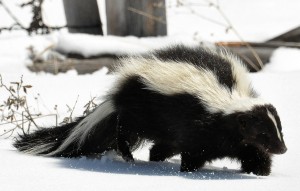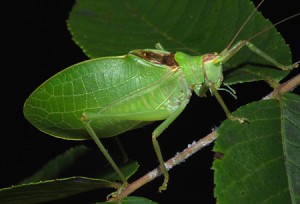Striped skunk (Mephitis mephitis)
Striped skunk (Mephitis mephitis). Photo by Dan Drzurisin.
Skunks don’t care that you can see their conspicuous black & white stripes. They know you are aware of there potential for spraying you with a disgusting thiol laced liquid from their anal scent glands. Bears leave them alone. But Great horned owls have no problem hunting them. This smell is apparent even when you drive over a skunk carcass in the road. They are frequently the victim of vehicles because their sense of sight is so poor. Nevertheless, they have excellent senses of smell and hearing. They even make good pets. Skunks eat insects, larvae, earthworms, grubs, lizards moles, eggs and small rodents. They can even eat bees since their thick fur protects them from stings. The eastern spotted skunk has whites spots instead of strips and is rare in Kansas.


